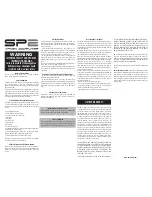
23
SWR (Standing Wave Ratio a.k.a. Voltage Standing Wave Ratio-VSWR)
SWR is a measurement of impedance matching of loads to the characteristic impedance of a
transmission line or waveguide. Impedance mismatches result in standing waves along the
transmission line. SWR is defined as the partial standing waves’ amplitude at an antinode
(maximum) to the amplitude at a node (minimum) along the transmission path.
It is often thought of as the maximum and minimum AC voltages along the transmission line lending
to the term VSWR (Voltage Standing Wave Ratio). For example: with a VSWR = 1.3:1 an AC voltage
due to standing waves along the transmission line is reaching a peak value 1.3 times that of the
minimum AC voltage along that line. Hence, SWR can be defined as the ratio of the maximum
amplitude to minimum amplitude of the transmission lines currents, electric field strength, or the
magnetic field strength. Neglecting transmission line loss these ratios are identical.
In general, the lower the SWR the better quality of the transmission line, component, antenna, or
antenna system under test. Each component of a system will have SWR defined for that item at its
designed frequency range. When an antenna system is designed the engineer will compute what the
maximum SWR should be at center frequency for that particular system. When a new system is
installed the SWR reading should meet or be low
er than maximum and be documented for “As Built”
or “Base Line” measurements. Later measurements can then be compared to the As Built
measurement to see if anything has changed.
Tips:
1.
When taking SWR measurements on a new system, measure the components separately first
and document each item’s SWR. Then measure the antenna system as a whole and document
that measurement. This will help later when measuring a faulty system to identify the component
that changed.
2.
When measuring a transmission line or line component in the line, be sure to attach an
impedance matched terminator at the far-end. An un-terminated line or component will show a
high SWR. Antenna’s are a termination in themselves
3.
Be sure about the line or component’s center frequency for which it was designed is correctly
entered in the MRI-3000.
This will center the SWR’s dip at or close to the center of the
measurement screen.
4.
If the lowest SWR reading is not on center frequency be sure to move the cursor to the
planned use center frequency and read the SWR at that frequency. The lowest point in the
waveform may meet system requirements, but the reading at the planned usage frequency is
what counts and that should also be under the maximum design specifications.
5.
If you are probing an indeterminant or unknown system, it is recommended to use the MRI-
3000 with a Broadband Calibration starting with a wide frequency sweep. Gradually change
the center frequency and span to locate the frequency(ies) of interest. You can then switch to
a frequency specific calibration to make more precise measurements if desired.
Return Loss
Return Loss is the loss of power in a transmitted signal due to impedance mismatches or
discontinuities in the transmission line, line components or antenna causing reflected power back to
the transmission’s source. It’s expressed in dB as defined by the equation shown below:
RL(dB)=Return Loss, Pi = incident power, and Pr = Reflected power
















































